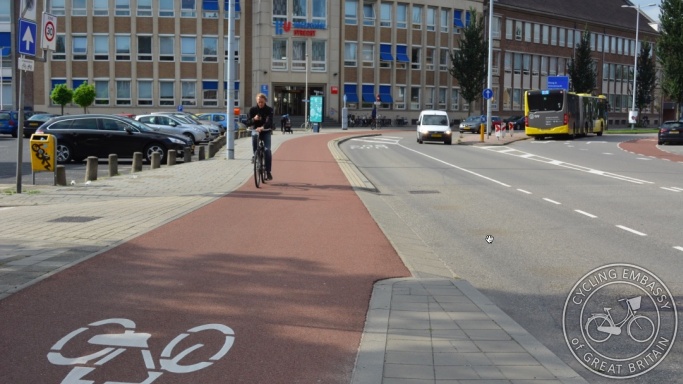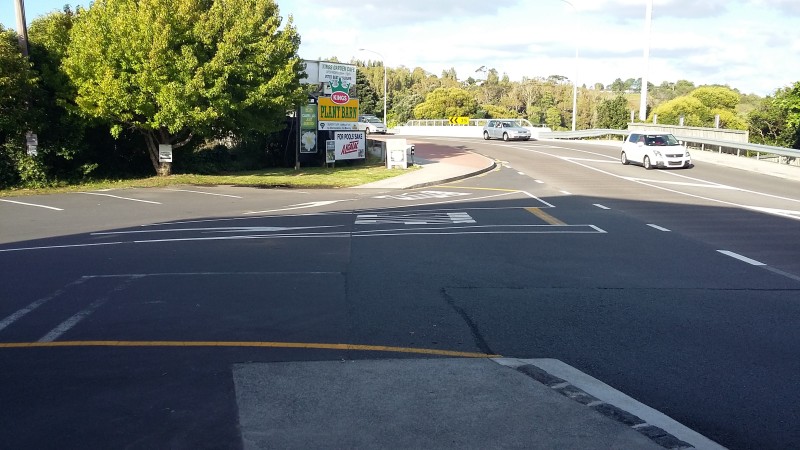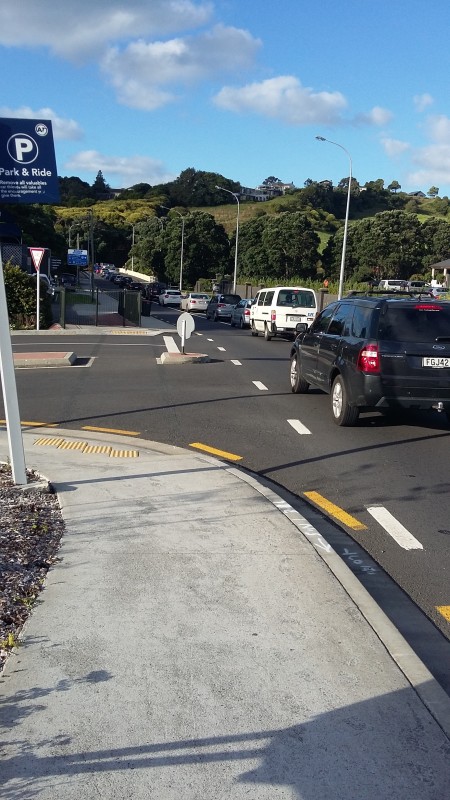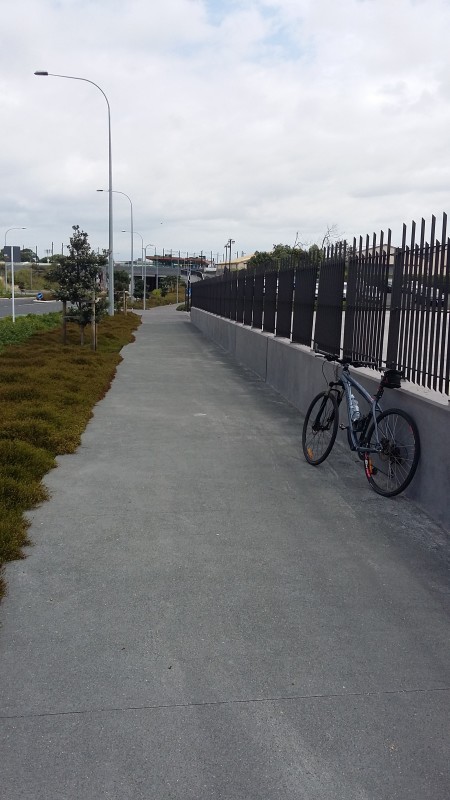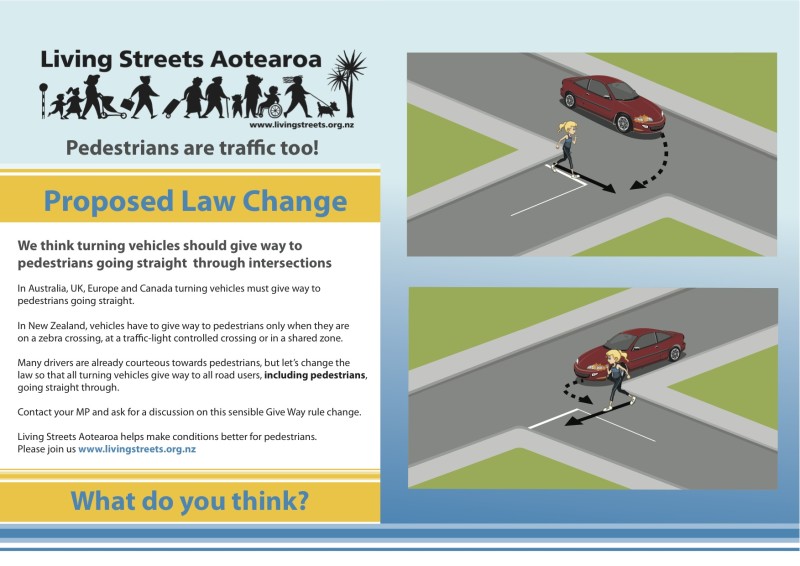Everyone thinks cycling in Dutch and Danish cities is so good because it’s flat.
But perhaps it’s because you don’t have to stop and start so often?
After 10 years in New Zealand there’s one thing I still can’t get used to: having to stop and start to cross side streets while I’m out for a run. Where I used to live, England, this scenario is barely cause for a second thought: a casual glance over your shoulder maybe, but your reasonable expectation is that you can keep going at the same pace. Which is incredibly helpful for running after dark, when main roads are often your best bet for smooth pavements and decent street lighting.
It’s the same in the USA, Canada, other parts of Europe, even Australia. But not here: in Auckland, every side street has the potential to turn a steady run into an interval-training session.
So I was pleasantly surprised the other day heading along Great South Road, approaching one of several side streets, when I looked over my shoulder to see a car approaching and indicating to turn into the side street. Just as I was about to grind to a halt, the driver waved me across. One less unwanted stop, and very welcome with 5km still to go and rain threatening. If only every driver was so courteous!
What’s this got to do with cycling? Well, if it’s painful having to stop and start on a run, it’s ten times worse on a bike. And we’re building more and more shared paths around Auckland, every one of which requires us – whether on a bike or on foot – to stop at every side street and give way to turning vehicles, for no other reason than because the New Zealand Road Code has afforded them the priority.
This reality is sometimes reflected, without a hint of irony, in the accompanying signage. Take this example on Mt Wellington Highway: strictly speaking, you should stop (and ideally, dismount) at the sign, cycle very slowly (or walk) across the side street, and get back up to speed after the next sign, once you’ve crossed to the other side. Yeah, right!
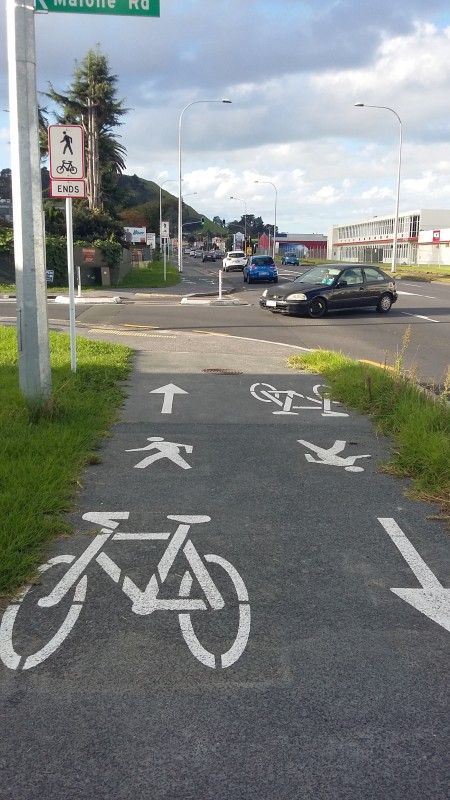 Why should people in cars (and on bicycles) traveling on Mt Wellington Highway itself get priority over turning vehicles – but not people on bicycles (or foot) traveling parallel on the shared path?
Why should people in cars (and on bicycles) traveling on Mt Wellington Highway itself get priority over turning vehicles – but not people on bicycles (or foot) traveling parallel on the shared path?
If it wasn’t for this bizarre rule, the shared path could simply run continuously, in a straight line, with no need for extra signs and chicanes.
Here’s another shared path, on Orakei Road. It doesn’t have the ironic signs, but does feature road markings that seem designed to keep any cyclists from getting ideas above their station. Here again, the shared path narrows and adds a sharp corner.
Despite the four-lane width, this is not a particularly busy side street, and may not even be a public street: it’s an entrance way to three or four commercial properties and few short-term car parks. Which begs the question: when is a side street not a side street?
This is an important consideration in New Zealand, because if it’s not a side street, but a ‘driveway that crosses a footpath’, then according to the Road Code, vehicles ‘must give way to people using the footpath’ (as well as vehicles using the road, of course). This also applies to shared paths, i.e. cyclists traveling legally off-road have priority when they cross driveways [By the way, legally driveways are ‘vehicle crossings’ – because it’s the vehicle crossing the footpath, and NOT vice versa].
Further up the road, there’s the entrance to the Orakei Station car park: is this a side street or a driveway? Probably a side street. As with the previous example, the stop lines are drawn right across the line of the path. And again, a chicane effect.
But what about this example, on Te Horata Road? This is surely a ‘driveway’. But are there any visual clues for vehicles (mostly articulated trucks) entering or leaving the yard to give way to cyclists?
There’s also an on-road cycle lane here, which the NZ Road Code treats very differently to shared paths: ‘If you [as a driver] are crossing a cycle lane, give way to cyclists before you cross’. But you don’t have to give way to pedestrians or cyclists on the shared path just beyond. It’s verging on Orwellian. Or maybe Kafka-esque (“Please consider Rulebook 15, subclause 27b for identification of appropriate rule set identifying priority when crossing – except on Tuesdays, when…”)
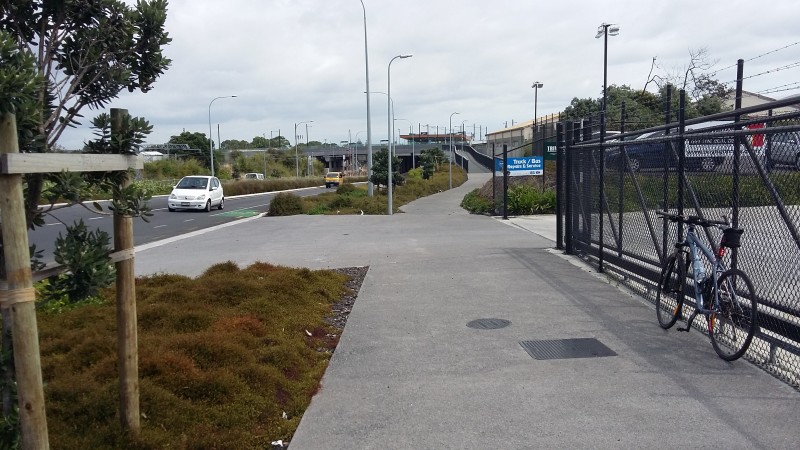 Take another striking (which is to say depressing) example: Greenlane East / West, close to Remuera Intermediate School. This is a route you might use if you want to cycle to Greenlane Train Station, or the business park, or Great South Road, or Cornwall Park at the weekend. It’s indicated on the AT cycling map as a shared path.
Take another striking (which is to say depressing) example: Greenlane East / West, close to Remuera Intermediate School. This is a route you might use if you want to cycle to Greenlane Train Station, or the business park, or Great South Road, or Cornwall Park at the weekend. It’s indicated on the AT cycling map as a shared path.
Starting at Peach Parade…
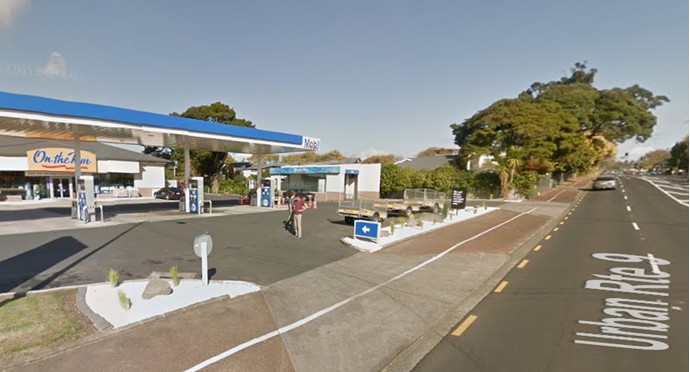 The Google Car whizzed through this section outside of peak hours, when it gets pretty crowded along this corridor. How many cars and trucks do you think wait for cyclists to cross before using the vehicle crossings? Either as they enter or exit the petrol station? How easy is it to turn and look behind you while you ride with your mates?
The Google Car whizzed through this section outside of peak hours, when it gets pretty crowded along this corridor. How many cars and trucks do you think wait for cyclists to cross before using the vehicle crossings? Either as they enter or exit the petrol station? How easy is it to turn and look behind you while you ride with your mates?
A little further west, the shared path peters out, squeezed between the traffic light and the ivy wall. There’s a two-stage dog leg crossing here, each with its own beg button: cyclists temporarily become pedestrians.
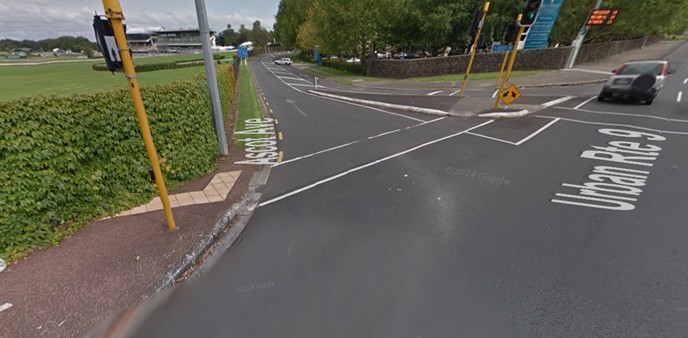 Well, at least they’re signalised.
Well, at least they’re signalised.
But why must cyclists wait here, twice? Because left-turning cars into this short section of Ascot Ave get priority. As do right-turning cars out of this short section of Ascot Ave. Further west, there’s another pedestrian crossing at Ellerslie Racecourse Drive, and an unsignalised slip lane to negotiate, where again cyclists (and walkers) get no priority.
Across the motorway, along a stretch of just 200 m between SH1 and Great South Road, there are at least six more similar vehicle crossings – and a side road with no signalised provision for cyclists.
Heading up Greenlane West, the going gets a little better because of the wide, tree planted berm which offers decent sightlines and a wider cycle path separate from the footpath, but the problem remains: each and every driveway is a potential hazard at which the cyclist is unprioritised and at risk, because the surface gives no visual clue to the prioritisation.
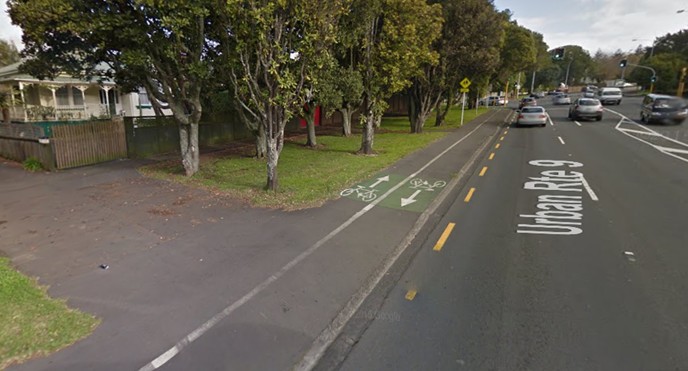 Then, crossing Wheturangi Road at the lights, cyclists become pedestrians again. After all of 300 m.
Then, crossing Wheturangi Road at the lights, cyclists become pedestrians again. After all of 300 m.
Finally, crossing Maugakiekie Road, westbound cyclists get to roll across… but only by using the narrow on-road cycle lane.
 It’s less than 1.3 km from Peach Parade to Wheturangi Road. This is a key route: the shared cycling / walking motorway over-bridge is a vital link – alternative routes involve a significant detour north or south, and are themselves devoid of any cycling provision at all.
It’s less than 1.3 km from Peach Parade to Wheturangi Road. This is a key route: the shared cycling / walking motorway over-bridge is a vital link – alternative routes involve a significant detour north or south, and are themselves devoid of any cycling provision at all.
Using the shared paths, cyclists have to contend with at least 20 unprotected and unprioritised vehicle crossings and driveways along the way, as well as five pedestrian crossings and two unsignalised side roads / slipways.
That’s more than one give way or stop every 50 meters! Whereas general vehicular traffic along this stretch gets relatively plain sailing: three sets of lights and a roundabout.
Why must we either stop and start like a pedestrian, or use a narrow unprotected on-road lane mixing with the cars and trucks? Why can’t users of a shared path just roll on through? (And indeed, why must pedestrians stop and start as well?)
It’s different in the UK Highway Code. Here’s the introduction to their section on junctions:
Take extra care at junctions.
You should watch out for cyclists, motorcyclists, powered wheelchairs/mobility scooters and pedestrians as they are not always easy to see. Be aware that they may not have seen or heard you if you are approaching from behind.
Watch out for pedestrians crossing a road into which you are turning. If they have started to cross they have priority, so give way.
Though custom and practice in the UK, in busy towns and cities at least, is that if you’re driving and turning you generally give the benefit of the doubt to the pedestrian (or the cyclist, on a shared path or cycle path) crossing the side street. The thing is, you worry that if it comes to it you’re going to have a tough time in court if you run someone down in a car while turning. That doesn’t seem to be the case in New Zealand.
Of course, most drivers don’t carry the Rode Code around in their heads, let alone in their cars – which is where street design comes into it, as an ever-present reminder of what’s expected. In Germany last year and in Holland three years ago, I noticed how often the cycle path (between the footpath amd the road) is often surfaced continuously, so that anyone entering a side street or crossing the path in a vehicle has to cross a visual barrier.
Check out this side-road crossing in Utrecht. (NB the side road is to the left of the photo, in front of the yellow rubbish bin).
The crossing is raised and continuous, and cars turning into the street have to mount a ramp. As the accompanying blog post says, ‘Even if a driver makes a mistake, it will happen at a slow speed.’
And here’s a simple example from Glasgow that, while not raised like the Dutch example, at least gives drivers a clue about relative priority.
 Contrast with this artist’s impression of a new development in Auckland, where the driveway design sends entirely the opposite message (actually, is that a driveway or a slide??). We appreciate that these are “just” artists images, and that the final may look different – but still, its clear that in NZ the default position is still stuck in “cars”. Full stop. Lots of full stops.
Contrast with this artist’s impression of a new development in Auckland, where the driveway design sends entirely the opposite message (actually, is that a driveway or a slide??). We appreciate that these are “just” artists images, and that the final may look different – but still, its clear that in NZ the default position is still stuck in “cars”. Full stop. Lots of full stops.
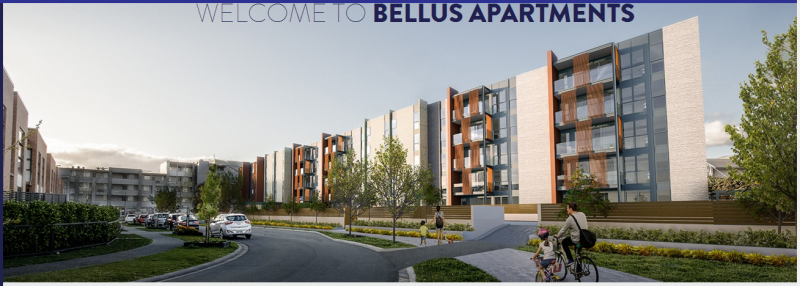 As a positive development, we understand NZTA is currently looking into the matter of side-street priority for people traveling straight ahead on footpaths and on shared paths (and the still-rare ‘cycle only’ path / Copenhagen lane).
As a positive development, we understand NZTA is currently looking into the matter of side-street priority for people traveling straight ahead on footpaths and on shared paths (and the still-rare ‘cycle only’ path / Copenhagen lane).
This is especially important for parking-protected bike lanes which run behind parked cars along major roads (adjacent to the berm or footpath). At the moment, in many cases designers have to consider whether to actually remove the protection (i.e. drop the cycle lane back to a paint-only solution) to ensure that cyclists are legally in the right to continue without interruption when it comes to intersections or signals!
As it turns out, we’ve written about this before (four years ago, in fact!), and we’re glad to hear this is being addressed at long last. Straight-through priority for people on foot and on bikes can’t come soon enough.
— Tim Duguid
PS The pedestrian advocacy group Living Streets Aotearoa is with us on this one: check out their campaign poster below, and more info here.

